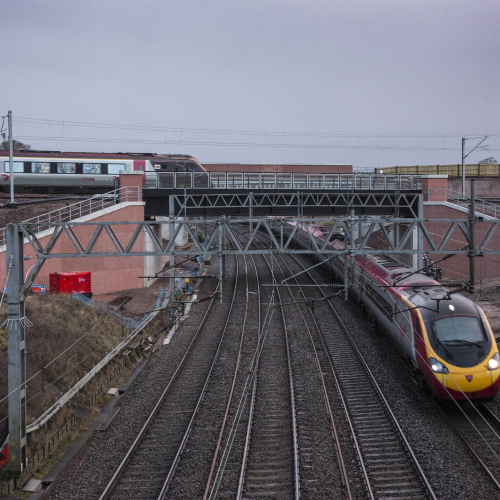
Passengers benefiting from £250m railway upgrade between Stafford and Crewe
Passengers are today (29 March) benefiting from a better railway through the Stafford area and can look forward to improved train services in future after a new section of railway was opened at Norton Bridge.
The new railway removes one of the last major bottlenecks on the West Coast main line by allowing trains travelling to Manchester from the south and West Midlands to travel over, rather than across, the existing tracks.
This will help create the capacity for more frequent services through the Stafford area as well as speeding up journeys and improving reliability on the West Coast main line, one of the busiest rail routes in Europe.
The scheme is a £250m investment, part of Network Rail’s £40bn Railway Upgrade Plan, which has also seen new modern, more reliable signalling installed and improvements between Stafford and Crewe to allow trains to travel at faster speeds.
Work has taken place over the last four years and has been delivered on budget and 18 months early.
A key part of the upgrade is the new rail-over-rail flyover which means trains to Manchester, via Stoke-on-Trent, will now travel over the existing lines rather than having to slow down and criss-cross the tracks; a move which restricted the number of trains which can pass through the area and slows them down.
The first train over the new flyover, at Norton Bridge, was the 5.11am CrossCountry service from Manchester to Bournemouth.
Secretary of State for Transport Patrick McLoughlin said: “We are investing over £40 billion in our railways in this parliament, which is the biggest upgrade since Victorian times. Not only is this project in Norton Bridge a major engineering achievement, it will also allow trains to travel faster through this area and bring more reliable services to one of the busiest rail routes in Europe, creating better journeys for those travelling across the Stafford region.”
The chairman of Network Rail, Sir Peter Hendy, said: “The opening of the new flyover and railway in the Norton Bridge area marks the culmination of four years’ work which will help provide passengers with a more reliable and better performing railway though the Stafford area on the West Coast main line, one of the busiest rail routes in Europe.
“We have removed one of the last major bottlenecks on the route which will improve the reliability of the railway and speed of trains though the area. It will also help run more freight and passenger services through the area and on the entire West Coast main line in future.
“Building this new railway to help provide improved services for passengers is part of our wider £40bn Railway Upgrade Plan, funded by the government, which will help meet the demands of an increasing number of passengers for many years to come. Our investment also helps the railway support economic growth, job creation and house building around Britain.”
Patrick Verwer, managing director at London Midland, said: “The new track layout at Norton Bridge is a major game changer of trains serving or travelling through Staffordshire. It will allow local and long distance services to pass through the county more easily making better journeys for everyone.”
Phil Bearpark, executive director of operations and projects at Virgin Trains, said: “We’re delighted at the opening of the new section of track on the West Coast Mainline. This is a significant piece of enhancement work that will benefit customers with increased reliability and lead to an improved rail network in the future.”
Andy Cooper, managing director of CrossCountry, said: ““By delivering this investment in increased capacity on the busy West Coast main line, Network Rail has improved the journeys of our customers by allowing us to provide more reliable services now and the prospect of faster journeys between Manchester and Birmingham in the near future.”
The scale of the project is vast with more than 200 engineering trains removing 5,200 lorry journeys from the local road network. Four rivers have been diverted, 11 new structures built, and more than 4,000 men and women involved in the upgrade.







